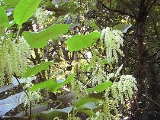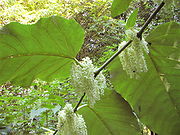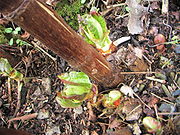
Fallopia sachalinensis
Encyclopedia
Fallopia sachalinensis (Giant Knotweed or Sakhalin Knotweed Japanese
オオイタドリ ooitadori, Russian
Горец сахалинский, Гречиха сахалинская; syn. Polygonum sachalinense F.Schmidt, Reynoutria sachalinensis (F.Schmidt) Nakai) is a species of Fallopia
native to northeastern Asia
in northern Japan
(Hokkaidō
, Honshū
) and the far east of Russia
(Sakhalin
and the southern Kurile Islands).
 It is a herbaceous
It is a herbaceous
perennial plant
growing to 2–4 m tall, with strong, extensively spreading rhizome
s forming large clonal colonies
. The leaves
are 15–40 cm long and 10–28 cm broad, nearly heart-shaped, with a somewhat wavy, crenate margin. The flower
s are small, produced on short, dense panicle
s up to 10 cm long in late summer or early autumn; it is dioecious
, with male and female flowers on separate plants. It is closely related to Fallopia japonica, and can be distinguished from it by its larger size, and in its leaves having a heart-shaped (not straight) base and a crenate margin. It has a chromosome
count of 2n=44.
 The shoot
The shoot
s are tender and edible. It was introduced to Europe
and grown in many botanic gardens. It came prominently into notice about 1893, when a drought
in western Europe caused a decided shortage in forage for cattle. This plant was little affected, and since its tender shoots and leaves were eaten by stock, the plant was widely grown experimentally as a forage crop
. It has proved less useful than was predicted, and its deliberate cultivation has been almost entirely abandoned. It has, however, like F. japonica, proved to be an invasive weed in several areas.
It has hybridised with Fallopia japonica in cultivation; the hybrid, Fallopia × bohemica (Chrtek & Chrtková) J.P.Bailey, is frequently found in the British Isles and elsewhere.
Japanese language
is a language spoken by over 130 million people in Japan and in Japanese emigrant communities. It is a member of the Japonic language family, which has a number of proposed relationships with other languages, none of which has gained wide acceptance among historical linguists .Japanese is an...
オオイタドリ ooitadori, Russian
Russian language
Russian is a Slavic language used primarily in Russia, Belarus, Uzbekistan, Kazakhstan, Tajikistan and Kyrgyzstan. It is an unofficial but widely spoken language in Ukraine, Moldova, Latvia, Turkmenistan and Estonia and, to a lesser extent, the other countries that were once constituent republics...
Горец сахалинский, Гречиха сахалинская; syn. Polygonum sachalinense F.Schmidt, Reynoutria sachalinensis (F.Schmidt) Nakai) is a species of Fallopia
Fallopia
Fallopia is a genus of about 12–15 species of flowering plants in the family Polygonaceae, often included in a wider treatment of the related genus Polygonum in the past. The genus is native to temperate and subtropical regions of the Northern Hemisphere...
native to northeastern Asia
Asia
Asia is the world's largest and most populous continent, located primarily in the eastern and northern hemispheres. It covers 8.7% of the Earth's total surface area and with approximately 3.879 billion people, it hosts 60% of the world's current human population...
in northern Japan
Japan
Japan is an island nation in East Asia. Located in the Pacific Ocean, it lies to the east of the Sea of Japan, China, North Korea, South Korea and Russia, stretching from the Sea of Okhotsk in the north to the East China Sea and Taiwan in the south...
(Hokkaidō
Hokkaido
, formerly known as Ezo, Yezo, Yeso, or Yesso, is Japan's second largest island; it is also the largest and northernmost of Japan's 47 prefectural-level subdivisions. The Tsugaru Strait separates Hokkaido from Honshu, although the two islands are connected by the underwater railway Seikan Tunnel...
, Honshū
Honshu
is the largest island of Japan. The nation's main island, it is south of Hokkaido across the Tsugaru Strait, north of Shikoku across the Inland Sea, and northeast of Kyushu across the Kanmon Strait...
) and the far east of Russia
Russia
Russia or , officially known as both Russia and the Russian Federation , is a country in northern Eurasia. It is a federal semi-presidential republic, comprising 83 federal subjects...
(Sakhalin
Sakhalin
Sakhalin or Saghalien, is a large island in the North Pacific, lying between 45°50' and 54°24' N.It is part of Russia, and is Russia's largest island, and is administered as part of Sakhalin Oblast...
and the southern Kurile Islands).

Herbaceous
A herbaceous plant is a plant that has leaves and stems that die down at the end of the growing season to the soil level. They have no persistent woody stem above ground...
perennial plant
Perennial plant
A perennial plant or simply perennial is a plant that lives for more than two years. The term is often used to differentiate a plant from shorter lived annuals and biennials. The term is sometimes misused by commercial gardeners or horticulturalists to describe only herbaceous perennials...
growing to 2–4 m tall, with strong, extensively spreading rhizome
Rhizome
In botany and dendrology, a rhizome is a characteristically horizontal stem of a plant that is usually found underground, often sending out roots and shoots from its nodes...
s forming large clonal colonies
Clonal colony
A clonal colony or genet is a group of genetically identical individuals that have grown in a given location, all originating vegetatively from a single ancestor. In plants, an individual in such a population is referred to as a ramet...
. The leaves
Leaf
A leaf is an organ of a vascular plant, as defined in botanical terms, and in particular in plant morphology. Foliage is a mass noun that refers to leaves as a feature of plants....
are 15–40 cm long and 10–28 cm broad, nearly heart-shaped, with a somewhat wavy, crenate margin. The flower
Flower
A flower, sometimes known as a bloom or blossom, is the reproductive structure found in flowering plants . The biological function of a flower is to effect reproduction, usually by providing a mechanism for the union of sperm with eggs...
s are small, produced on short, dense panicle
Panicle
A panicle is a compound raceme, a loose, much-branched indeterminate inflorescence with pedicellate flowers attached along the secondary branches; in other words, a branched cluster of flowers in which the branches are racemes....
s up to 10 cm long in late summer or early autumn; it is dioecious
Plant sexuality
Plant sexuality covers the wide variety of sexual reproduction systems found across the plant kingdom. This article describes morphological aspects of sexual reproduction of plants....
, with male and female flowers on separate plants. It is closely related to Fallopia japonica, and can be distinguished from it by its larger size, and in its leaves having a heart-shaped (not straight) base and a crenate margin. It has a chromosome
Chromosome
A chromosome is an organized structure of DNA and protein found in cells. It is a single piece of coiled DNA containing many genes, regulatory elements and other nucleotide sequences. Chromosomes also contain DNA-bound proteins, which serve to package the DNA and control its functions.Chromosomes...
count of 2n=44.
Cultivation and uses

Shoot
Shoots are new plant growth, they can include stems, flowering stems with flower buds, and leaves. The new growth from seed germination that grows upward is a shoot where leaves will develop...
s are tender and edible. It was introduced to Europe
Europe
Europe is, by convention, one of the world's seven continents. Comprising the westernmost peninsula of Eurasia, Europe is generally 'divided' from Asia to its east by the watershed divides of the Ural and Caucasus Mountains, the Ural River, the Caspian and Black Seas, and the waterways connecting...
and grown in many botanic gardens. It came prominently into notice about 1893, when a drought
Drought
A drought is an extended period of months or years when a region notes a deficiency in its water supply. Generally, this occurs when a region receives consistently below average precipitation. It can have a substantial impact on the ecosystem and agriculture of the affected region...
in western Europe caused a decided shortage in forage for cattle. This plant was little affected, and since its tender shoots and leaves were eaten by stock, the plant was widely grown experimentally as a forage crop
Fodder
Fodder or animal feed is any agricultural foodstuff used specifically to feed domesticated livestock such as cattle, goats, sheep, horses, chickens and pigs. Most animal feed is from plants but some is of animal origin...
. It has proved less useful than was predicted, and its deliberate cultivation has been almost entirely abandoned. It has, however, like F. japonica, proved to be an invasive weed in several areas.
It has hybridised with Fallopia japonica in cultivation; the hybrid, Fallopia × bohemica (Chrtek & Chrtková) J.P.Bailey, is frequently found in the British Isles and elsewhere.

